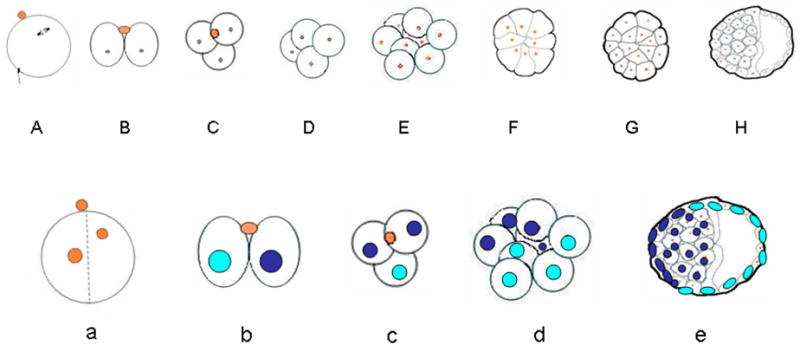Fig. 1.

An outline of early development in the mouse. The upper diagram (A), which is based on Fig. 1 of Johnson & McConnell [4] illustrates development from fertilization to the 32-cell expanding blastocyst, during which time the conceptus is enclosed within the zona pellucida (not shown). No net growth occurs during this period so that cells become progressively smaller. A, oocyte at the time of fertilization (0 h), with the 2nd meiotic spindle and the first polar body marking the so-called animal pole of the egg.; B, 2-cell stage conceptus at (~20) h after a meridional division had occurred approximately along the animal-vegetal axis of the zygote (noted in about 75% of cases) with the second polar body positioned between the two blastomeres; C, 3-cell conceptus, which, in the CF1 strain of mouse used in this laboratory, is noted in the majority of conceptuses between 26 and 30 h; D, 4-cell stage (~36 h); E, 8-cell stage (~48 h) before compaction; F, 8-cell stage (~52h) after compaction; G, 16-cell morula (~60h) with an established inner cell population; H, 32-cell blastocyst (84 h; not all cells shown). Note that there is considerable variation in the timing of stages both between and also within strains of mice.
The lower panel (B) illustrates one possible outcome of pre-patterning in early mouse development following a cleavage plane that occurs approximately along the animal vegetal axis of the egg. As shown in a, in about 75% of cases, cleavage occurs within 30° (indicated by the broken lines) of either side of this animal-vegetal pole axis (defined here by the position of the 2nd polar body colored in orange). According to the pre-patterning hypothesis, the two blastomeres at the 2-cell stage are distinct and have become allocated to two separate lineages (illustrated here with blue and aquamarine nuclei). Although these lineages are not completely fixed and depend upon the planes of subsequent cell divisions, in a high proportion of cases, the blastomere that divides first (b & c), will contribute to the embryonic pole of the blastocyst (e), while the one that divides last will be the precursor of mural trophectoderm located towards the abembryonic pole. Thus, the cleavage plane of the zygote defines the eventual clonal boundary between the two lineages.
